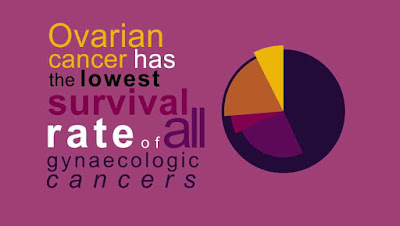Ovarian cancer is a malignant tumour that develops on one or both ovaries. It is also called ovarian cancer or ovarian carcinoma.
There are different forms of ovarian cancer, depending on the type of ovarian tissue in which the tumor develops. This differentiation is important because each form requires another type of treatment. In 90% of cases they are epithelial tumors, which develop from the cells of the superficial layer of the ovary.
What are the symptoms?
The symptoms usually appear quite late, because the ovaries float freely in the abdominal cavity.At first, the symptoms are rather vague:
- stomach aches
- nausea
- tired
- irregular blood loss through the vagina
- inexplicable exhaustion and weight loss
- dizziness
If these symptoms persist for 3 to 4 weeks without change, further examination is required.
As the cancer progresses, it can put pressure on nearby organs. In more advanced states it can spread in an abdominal cavity (to a peritoneum, intestines, a diaphragm and lymph nodes).
In this case may appear symptoms such as:
- swollen belly (increase in waist circumference)
- constipation
- need to urinate often
What is the cause?
In most cases, you cannot find a specific cause for ovarian cancer. The average age for the onset of this cancer is 56 years old. One in every 70 women is at risk for ovarian cancer.There are certain factors that would protect against ovarian cancer, such as multiple pregnancies and use of the contraceptive pill.
It happens that in the same family several women develop ovarian cancer. There is an increased risk of ovarian cancer if at least two first-degree relatives have cancer, such as mother and daughter, or two sisters. This is why it is now advisable to do genetic screening in all women with ovarian cancer.
In only 5 to 10% of family cases, ovarian cancer is hereditary. In the other cases it is chance. Hereditary forms usually appear in association with cancers in other organs, such as breast cancer or colorectal cancer. A DNA analysis then makes it possible to detect mutations of the BRCA genes (BRCA1 and BRCA2). In the presence of such mutations the risk of ovarian cancer is much higher, ie 2 to 4 women out of 10.
What treatment?
Customized treatment is today the general rule.Treatment will depend on:
- the type of ovarian cancer
- the speed with which cancer evolves
- the stage (only at the level of the ovary or affected neighbouring organs)
- the presence or absence of seeding to the lymph nodes
Three treatment options are possible:
- Healing: it means with the goal of healing
- Adjuvant: this means as an adjunct to another treatment such as surgery
- Palliative: that is with the aim of curbing the evolution of the disease and / or relieving the symptoms
Ovarian cancer can be treated by:
- surgery
- chemotherapy
- radiation (radiotherapy)
- an association of two or three kinds of treatment
Why a surgical operation?
The treatment of ovarian cancer is almost always surgical. In this case the surgeon will try to completely remove the ovary with cancer.If the cancer has already spread in the abdominal cavity, it will try to eliminate all visible cancer tissue. This is called "debulking": the other ovary, the matrix, a fold of the peritoneum, and often the lymph nodes of the abdominal cavity and groin are also removed.
In fact, it has been shown that the less cancerous tissue remains, the more effective the adjuvant or supplemental treatment will be.
Depending on the extent of the cancer the operation will be via an endoscope (laparoscopy) or open belly (laparotomy).
Why chemotherapy?
The goal of chemotherapy is to stop the multiplication of cancer cells.- Before the operation: to reduce the volume of the tumor and thus facilitate the operation
- After the operation: to destroy the invisible residual cancer cells and thus increase the chances of healing
- Palliative: to temporarily slow the growth of the tumor and reduce pain or symptoms in a more advanced stage
Chemotherapy consists of different drugs that are often associated and administered by cures. The number of courses will depend on the extent of the illness, the general condition of the patient, and the body's response to treatment.
This may differ from patient to patient. The disadvantage of chemotherapy is that healthy cells are also attacked by the treatment.
Here are the known side effects:
- tired
- hair loss
- nausea and vomiting
- intestinal problems
- increased risk of bleeding and infections
The type of side effect depends on the products used. But most side effects can be fought with medication. Sometimes it is necessary to postpone for a short period a course of chemo until the body has partially recovered.
When do you need rays?
Cancer cells can also be killed by irradiation. The dose is calculated individually. The entire abdomen and pelvis are irradiated in sessions of a few minutes a day, for 5 days a week, for four to five weeks.Irradiation or radiotherapy also causes side effects, because the rays affect all organs of the abdomen. This can lead to nausea and vomiting, or diarrhea, or the urge to urinate often.
The irradiation can be applied in addition after an operation or to reduce the pain due to metastases (for example in the bones and lymph nodes). In the latter case we speak of palliative radiation: the radiation dose is then lower and has fewer side effects.



0 Comments